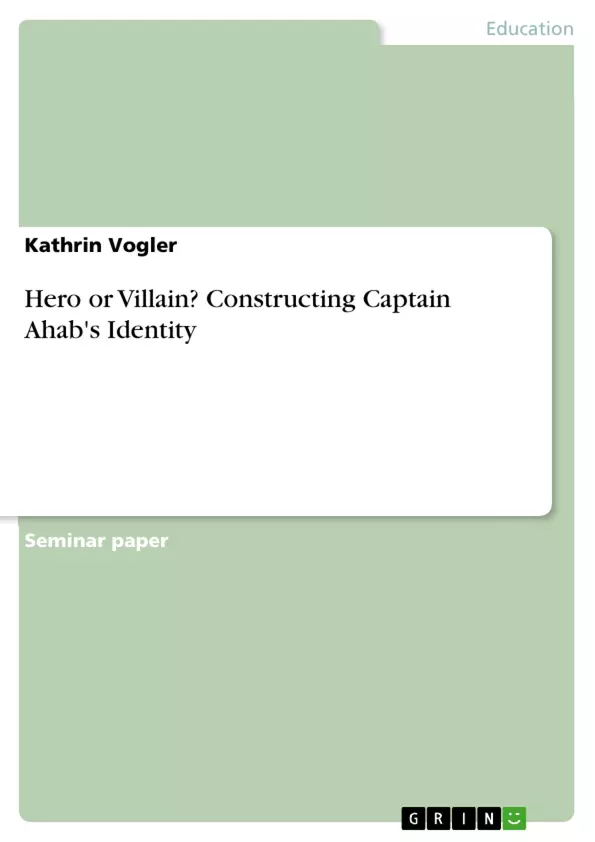In 1851 Herman Melville published his novel "Moby-Dick; or, The Whale" which is considered an outstanding work of Romanticism and the American Renaissance. Although it was a commercial failure at first, its reputation as a Great American Novel grew during the twentieth century. Other authors admit they wished they had written it themselves and praise the novel.
What makes the novel especially interesting is the protagonist, Captain Ahab, who is on a monomaniacal quest for revenge on the white whale Moby Dick that took his leg on a previous voyage. The scholars’ opinions about Ahab range from being a villain to being a hero, whereby some scholars might feel ambiguous and hesitant to put Ahab in either one of the categories. The complexity of Ahab’s character makes it hard to categorize him in either good or bad because he really displays qualities of both.
This paper’s aim is to look behind Captain Ahab’s façade in order to find out how Melville constructed his protagonist and why he constructed him the way he did. First of all it is important to look at some key features that occur in Ahab’s character, namely the battle between free will and fate, madness and obsession with revenge. The second part of this paper takes a closer look at possible influences on the construction of Captain Ahab by comparing Ahab to other leaders: In a comparison to King Ahab of Israel the topic of religion in Moby Dick will be mentioned, a comparison to Milton’s Satan will deal with Ahab’s satanic features and the last comparison will connect Ahab to the tragic hero of Shakespeare. Finally the main findings will be summarized in a conclusion.
Table of Contents
- I. Introduction
- II. Hero or Villain? – Constructing Captain Ahab's Identity
- 1. Characterising Ahab
- 1.1 Free will versus fate
- 1.2 Madness
- 1.3 Obsession & Revenge
- 2. Ahab compared to other leaders
- 2.1 King Ahab of Israel
- 2.2 Milton's Satan
- 2.3 The Shakespearean Hero
- 1. Characterising Ahab
- III. Conclusion
Objectives and Key Themes
This paper aims to analyze the construction of Captain Ahab's character in Herman Melville's Moby-Dick, examining why Melville chose to portray him in such a complex and multifaceted way. The paper investigates the factors that contribute to Ahab's character, specifically focusing on the tension between free will and fate, his descent into madness, and his consuming obsession with revenge.
- The struggle between free will and determinism in Ahab's actions.
- The manifestation of Ahab's madness and its impact on his decisions.
- The nature and influence of Ahab's obsession with revenge on Moby Dick.
- The comparison of Ahab to other notable figures in literature and history.
- The potential religious and philosophical implications of Ahab's character.
Chapter Summaries
The chapter "Characterising Ahab" delves into the complex personality of Captain Ahab, exploring key features that define his character. The section on "Free will versus fate" examines Ahab's internal conflict regarding his agency in his actions, considering whether he acts upon his own desires or is subject to a higher power. The chapter then explores Ahab's descent into madness, arguing that his obsession with Moby Dick, coupled with his internal conflict about free will, contributes to his mental state. Finally, the chapter examines the concept of Ahab's obsession with revenge, highlighting his single-minded focus on his ultimate goal.
The chapter "Ahab compared to other leaders" expands upon the analysis of Ahab's character by comparing him to other prominent figures in literature and history. This comparison provides additional insight into Ahab's character, highlighting the thematic and philosophical implications of his actions. The comparison with King Ahab of Israel explores the religious aspects of Moby-Dick, while the comparison with Milton's Satan examines Ahab's satanic qualities. Finally, the chapter compares Ahab to the tragic hero of Shakespeare, exploring his heroic qualities in the face of his destructive tendencies.
Keywords
This paper focuses on the construction of Captain Ahab's character, exploring the themes of free will and determinism, madness, obsession with revenge, and the comparison of Ahab to other significant figures. These themes are explored through an analysis of Moby-Dick, drawing upon the novel's narrative structure, symbolism, and character development to uncover the complexity of Ahab's persona. Through this analysis, the paper sheds light on the multifaceted nature of Ahab's character, showcasing him as a complex and compelling figure that embodies both heroic and villainous qualities.
- Citation du texte
- Kathrin Vogler (Auteur), 2015, Hero or Villain? Constructing Captain Ahab's Identity, Munich, GRIN Verlag, https://www.grin.com/document/366477



